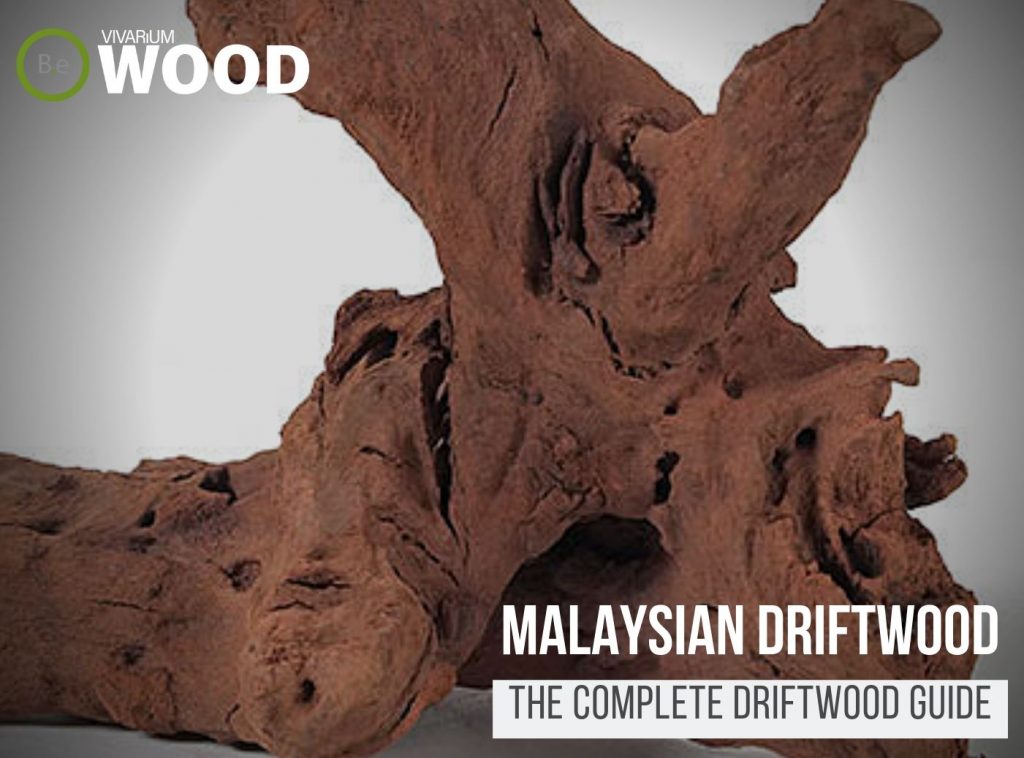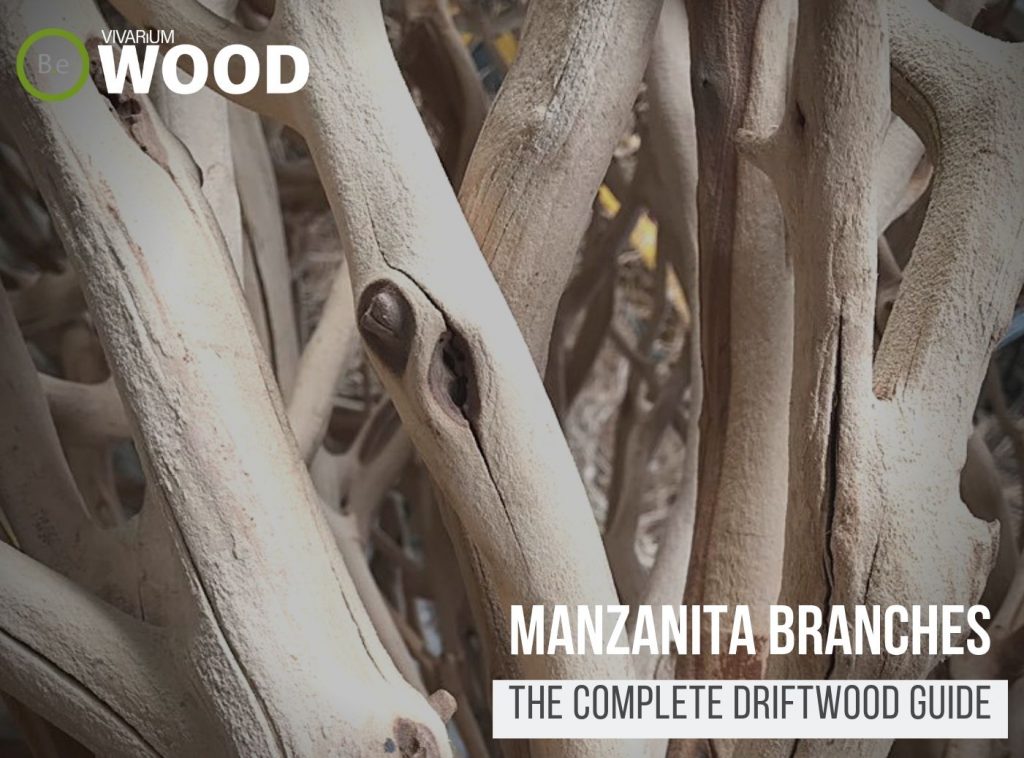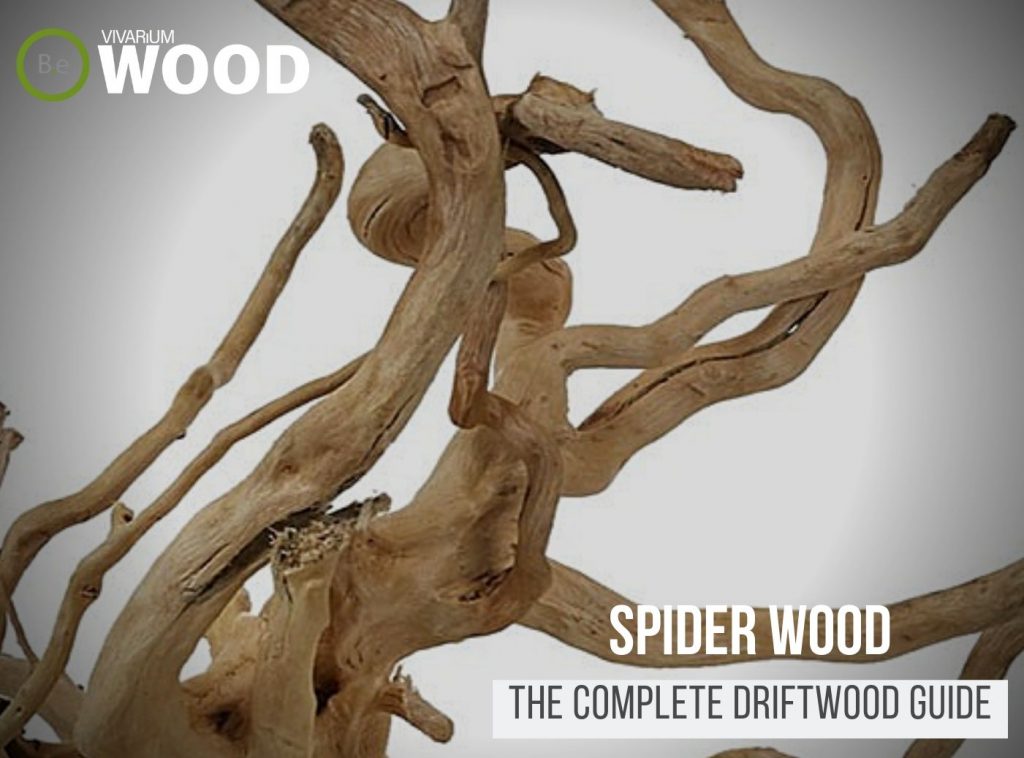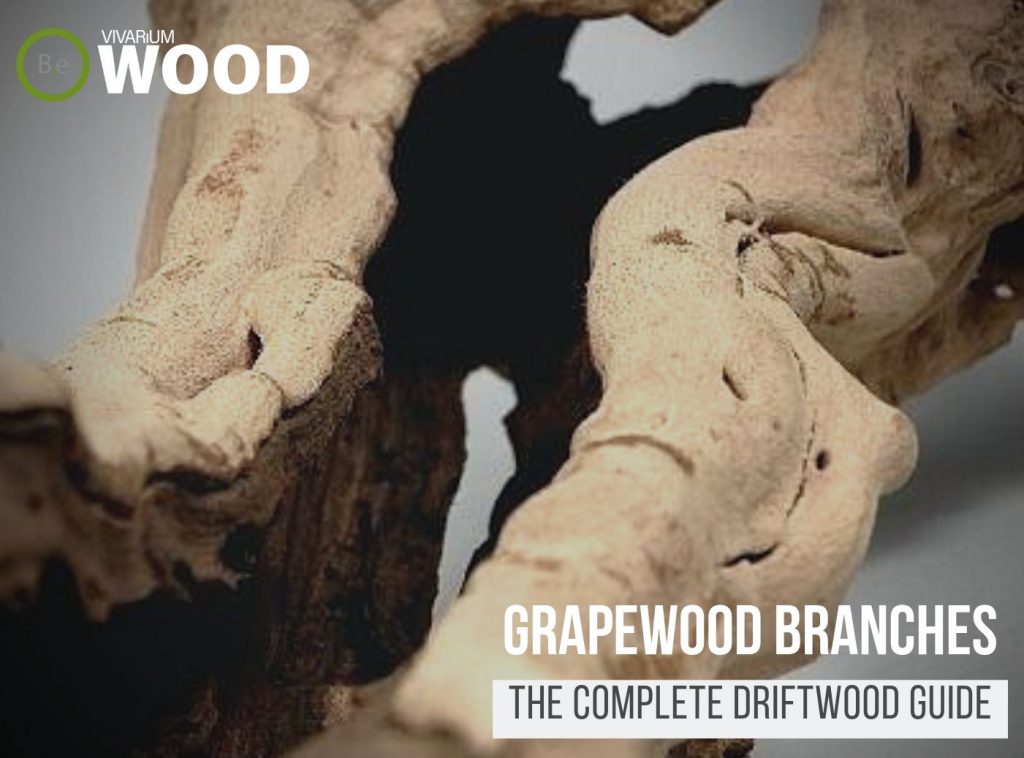Wood is a very natural way to both nourish and decorate a vivarium. It is an essential part of the ecosystem and in many cases an absolute necessity. Many hobbyists consider driftwood to be the best choice to go with over the infinite amounts of wood found in nature today.
But what exactly makes a fallen branch or broken trunk driftwood? Furthermore, is driftwood the only type of hardwood suitable for use as a hardscape material in any type of vivarium setup? This article will provide a good understanding of vivarium wood as well as list the best types of wood acceptable for several tanks.
If you are building a vivarium from the ground up, you should have already considered the rockscape as it is a crucial first step in setting up the foundation. Finding the right driftwood will be the next part of this process. Check out my guide on vivarium rocks if you haven’t already to get a good idea of what rocks should go in the tank before you consider any of the woods on this list.
Furthermore, before diving into an in-depth list of suitable wood to consider for any type of vivarium, I would like to first cover a few important aspects of wood that will give insight into how they work in conjunction with the tank… This will make hardscape or substrate choices easier to construct as you plan your build.
Table Of Contents:
ToggleWhat Is Driftwood?
In the wild, driftwood is a piece of wood that is found floating in moving water or that has been washed ashore. This wood has been saturated in water long enough to remain submerged and depleted of any hazardous substance that would pose a threat to aquatic life.
Tree sap or other chemicals produced by the plant during its life cycle would be examples of potentially dangerous matter that water will naturally dissolve when wood becomes driftwood.


When it comes to the vivarium niche, the term is used more vaguely to identify acceptable wood even if it hasn’t or will not be water bogged. Many plants produce wood that can become suitable for the enclosure.
As long as it doesn’t pose a threat to the inhabitants living within the same tank it can be potentially used as hardscape or substrate material. If you are building a vivarium from the ground up, you should have already considered the rockscape as it is the crucial step in setting up the foundation. Finding the right driftwood will be the next part of this process.
Vivarium Wood
In many cases, vivarium wood will be an absolute necessity for the completion of an enclosure. Aviaries will need birches for birds, Terrariums will need branches for reptiles and amphibians, and Aquariums will need trunks for fish.
No matter what type of animal is being kept or the vivarium is being made, the wood will need to be safe, sturdy, and beneficial to the environment in one way or another.
There are a few things to keep in mind when considering potential driftwood for a habitat… What benefits should be expected from the utilization of that wood… What negative effects will the wood have on the environment…
If you are going to make your own driftwood or find it outdoors, what should be done in preparation to ensure the wood is going to work as intended for the enclosure… I’ll go more into detail about these important factors down below.
Benefits Of Using Vivarium Wood
There are a number of advantages one can expect from vivarium wood if done correctly. Depending entirely on the type of setup and animals inhabiting the enclosure, the benefits will range. The two main variations of setups involving wood will either be in an aquatic or non-aquatic environment.
Terrariums are great examples of nonaquatic environments vivarium woods can provide benefits for. In many instances, wood can act as a sanctuary for pets to feel secure, eat, or breed. Plants will use the surface as a source of substrate to absorb nutrients.
Branches provide the needed height for reptiles, amphibians, and plants to climb closer to a source of light and heating. Furthermore, birds will opt to do the same in aviaries.
Aquatic environments like aquariums, ripariums, and the lower section of paludariums also see the advantages of using driftwood. Wood will leech beneficial tannins into the water often buffering pH and water hardness down to ideal levels.
Fish and invertebrates will use the wood for cover when they feel threatened or want to rest. Aquatic plants will also latch onto the surfaces of some wood and use it as a substrate source.


Things To Avoid
There are a few things to avoid when it comes to using driftwood in a vivarium of any sort. It’s natural for many kinds of wood to decompose and in many cases, it can be beneficial to the environment. The rate of decay is what to be cautious about.
You don’t want to put soft or brittle wood in a tank that will break down so fast that it will make a mess or provide a poor structure to build off of.
Many of the woods we recommend are considered softwood but they work well in an enclosure because they decay relatively slowly… And the benefits out the way their life span.
Another problem with many kinds of wood is the toxins some release over time. Many kinds of wood like cedar, pine, and willow contain high levels of tree sap which can be very poisonous to some inhabitants when leeched into the enclosure.
Always buy wood from a reputable source that specializes in the vivarium hobby to avoid instances where misidentified wood may present toxic material or pesticide treatment.
One final warning is to work with wood in small pieces. Larger pieces of driftwood present the danger of containing unwanted debris or pests. It is easier to secure smaller pieces of wood and stack them as opposed to securing larger pieces.
If the driftwood is not properly put in a way that it doesn’t shift, it can be fatal to local animals or cause damage to the tank if fallen.
How To Find Driftwood
There are several good ways to find driftwood for an aquarium or terrarium. Anywhere there are large bodies of water, chances are there is driftwood nearby. Especially after a big storm has taken place. Beach shores, river valleys, and ponds are all great places to look for suitable wood that has washed up.
Once the wood has had a good amount of time to sit in water, it should be saturated enough to use. Always let the wood dry out completely before use.
The safest approach to obtaining driftwood, bark, or any other sort of vivarium wood in that manner is to buy it from a reputable retailer that sells hardscape material specifically for vivarium use. I prefer going with a source that specializes in the aquarium niche even if the wood will be for terrarium use.
This assures the wood is safe and I always have the option later to use it in an aquatic setting if I choose to do something different.


Types Of Vivarium Wood
There are mainly two types of vivarium wood to choose from when deciding on a suitable source of hardscape or substrate material. Driftwood is for aquatic use and dry wood is more appropriate for non-aquatic use.
They both can and are in many cases used interchangeably but for the sake of longevity and safety, some are more beneficial for certain biotypes. This list will be organized by type and briefly explain why they were chosen for this guide.
Safe Aquarium Driftwood
Safe aquarium driftwood comes in many unique forms and sizes. These types of woods are made up of both hard and softwoods. This group should always be non-toxic and completely safe for animals as well as plants.
They either decay very slowly or are rot-resistant altogether. Even though they are considered aquarium driftwood, they can easily coexist in dry setups like terrariums.
Below is a complete list of safe aquarium driftwood suitable for both aquariums and terrariums:
Malaysian Driftwood (Blackwood)
Malaysian driftwood is thought by many to be the staple child for driftwood. This is usually what comes to mind when hobbyists think of driftwood. Every aspect of this wood makes it ideal for aquarium use. It’s heavy enough to sink almost instantly…
Animals find it very beneficial as a source of food… It buffers freshwater biotypes to suitable levels of pH under 7. The only drawback with this driftwood to some is the dark color it will change water to. On the contrary, this is usually a sought-after feature for blackwater tanks.
Malaysian driftwood is one of the most popular woods to consider in aquascaping. It is indigenous to Malaysia and one of its biggest imports. This wood is not rot-resistant but at the rate of decay, it will last long enough to feel like it isn’t going anywhere any time soon. Check out this extensive guide about Malaysian Driftwood (Blackwood) for more information about this type of wood.
California Driftwood (Ghostwood)
Ghostwood is a new up-and-coming wood within the vivarium hobby. It is the perfect alternative to Malaysian driftwood. It offers all the same benefits as other hardscape woods minus the water tinting.
The unusual formation offers hobbyists a unique look in a vivarium that cannot be compared. This wood is rare material to find but the type that is often sold within the US is usually from California.
California driftwood is a pale-colored wood that few can complain about. It is great for any biotype and looks just as good underwater as it does above ground. Use this wood carefree in any vivarium and expect longevity with Ghostwood. Check out this extensive guide on California Driftwood (Ghostwood) for more information about this type of wood.
Mopani Wood (Gnarly Driftwood)
Mopani Wood is driftwood indigenous to the northern parts of South Africa. The perennial plant this wood is harvested from is called Colophospermum Mopane. It is one of a kind and the only species of plant within its genus.
This wood exhibits a unique two-tone pattern of tan and dark brown. It is considered a hardwood making it very dense and hardy. It will break down extremely slowly making it ideal for aquatic use.
Mopani driftwood is thought to be the perfect wood for softwater tanks as it will lower pH drastically no matter what alkaline-inducing matter coexists within the vivarium. Sinking this wood is relatively simple and may not require long periods of presoaking. Check out this extensive guide about Mopani Wood (Gnarly Driftwood) for more information about this type of driftwood.
Red Manzanita Branches (Manzanita Wood)
Manzanita wood, also known as Red Manzanita branches, has been the go-to driftwood within the aquarium hobby since the beginning. This wood is easily found all over the world and comes from various species within the genus Arctostaphylos.
It is mostly known for its extravagant look underwater and its slow decomposition. In addition, it is non-toxic and can be beneficial to animals as a source of food and nutrients for plants.
Manzanita wood is an excellent choice of wood for aquariums that need to be buffered to lower pH. Furthermore, this wood is great for many other types of vivariums as well. It can be used for perches in aviaries so birds have a place to climb and rest. In addition, it also comes in a variety of colors to choose from like red, white, brown, and black. Check out this extensive guide about Red Manzanita Branches (Manzanita Wood) for more information about this type of wood.
Spider Wood (Azalea Roots)
Spider wood is driftwood that comes from the roots of various species of trees. Commonly referred to as Azalea roots and Rhododendron roots, this wood can exhibit multiple branches that intertwine around one another.
This driftwood is very appropriate for aquarium use due to its slow decay rate and beneficial tannin release. Use this wood in softwater setups that require pH levels under 7.
Spider wood is mostly found in red but can also appear in lighter tan colors. Plants easily attach to the surface of this wood making it a great source of substrate matter. Wood-loving animals will nibble at this softwood over time as well. Check out this extensive guide about Spider Wood (Azalea Roots) for more information about this type of wood.
Cholla Wood (Cacti Wood)
Cholla wood, also known as Cacti wood, is a unique wood that comes from the skeleton of the Cholla species cactus plant. The patterns exhibited on this wood are so detailed it almost looks artificial.
These desert trees produce a wood that is light, porous, and very easy to submerge. This is an interesting wood to consider if you want to mix things up in a vivarium.


Cholla wood is great for both aquariums as well as terrariums. In addition, it is safe for reptiles, fish, and other animals to be around. Even though we recommend this wood for aquatic tanks, its rate of decomposition should be monitored.
This wood will break down faster than most driftwood and become too brittle to work with. Check out this extensive guide about Cholla Wood (Cacti Wood) for more information about this type of wood.
Safe Terrarium Wood
Terrarium wood can be a bit trickier in the sense that it can work in all types of vivariums but is either not meant to last in aquatic settings long term or just more commonly used strictly for terrariums due to aesthetics.
Many types of terrarium wood-like bark are traditionally utilized as backgrounds due to the natural way they occur in the wild. This group of woods is going to aid in helping the vivarium appear denser and forest-like.
Below is a complete list of safe terrarium wood suitable for both aquariums and terrariums:
Bamboo Wood (Stakes, Poles & Hides)
Bamboo Wood is material harvested from bamboo plants once it has died and is no longer evergreen. The interesting part about this wood is that it comes from a type of grass instead of the tree-like woods on this list.
It gives off a very Asian-themed forest and is great for anchoring other plants upright. They come in a variety of sizes and lengths as well and are rot-resistant, pest-resistant, and nontoxic once completely brown.
Bamboo wood is one of the few kinds of wood on this list that releases such a small amount of tannin that it virtually leaves no water tint. This wood can be used in a number of biotypes.
Due to the heavy culture surrounding its origin, many choose to only use it in Chinese garden-themed enclosures. Check out this extensive guide about Bamboo Wood (Stakes, Poles & Hides) for more information about this type of wood.
Grapewood Branches (Grapevine)
Grapewood branches, also known as grapevines, are wood harvested from vineyards once the plant has retired from producing grapes. This wood is unique and has a lot of personalities.
When compared to other vivarium wood, it doesn’t leech the same amount of tannins leading to less likelihood of tinted water. Presoaking will easily remove excess tannin and allow this wood to sink more easily.
It isn’t uncommon to find hobbyists using grapevines in aquariums. It is a safe wood to use and can provide beneficial nutrients to animals that feed on the wood as well as the biofilm produced as it breaks down.
On the contrary, this wood is not rot-resistant and is known to decompose relatively fast when submerged for long periods. This is why we consider it better suited for a terrarium. Check out this extensive guide about Grapewood Branches (Grapevine) for information about this type of wood.
Cork Bark (Rounds, Flats & Hides)
Cork Bark is the outer layer of a species of perennial plant known as Quercus Suber. Commonly referred to as Cork Oak Trees, these plants can regrow a dense hide of bark over nine years.
Cork is light, rot-resistant, and waterproof. It is commonly used as material for backgrounds in terrariums but it is also suitable for use in aquariums. The only downside to its use in aquascaping is it floats and will have to be mounted to remain in place.
Cork Bark comes in a variety of shapes and sizes. It can be purchased as a flat piece, a semi-log, or as a whole hide. Above all, this is a great hardscape wood for animals to find cover as well as plants to latch on to and use as a type of substrate. Check out this extensive guide about Cork Bark (Rounds, Flats & Hides) for more information about this type of bark.
In Summary
Vivarium wood is an extremely beneficial way to decorate an enclosure. It should easily coexist with the vivarium as well as its inhabitants. Deciding on the right type of wood can be a process but shouldn’t be difficult to do now that you know what to look for.
Experiment with different driftwood in different biotypes and see what works best. A happy tank means a healthy ecosystem. Always keep in mind, that the majority of wood will buffer pH. In addition, driftwood should only be considered for environments that thrive on water parameters under 7 pH.
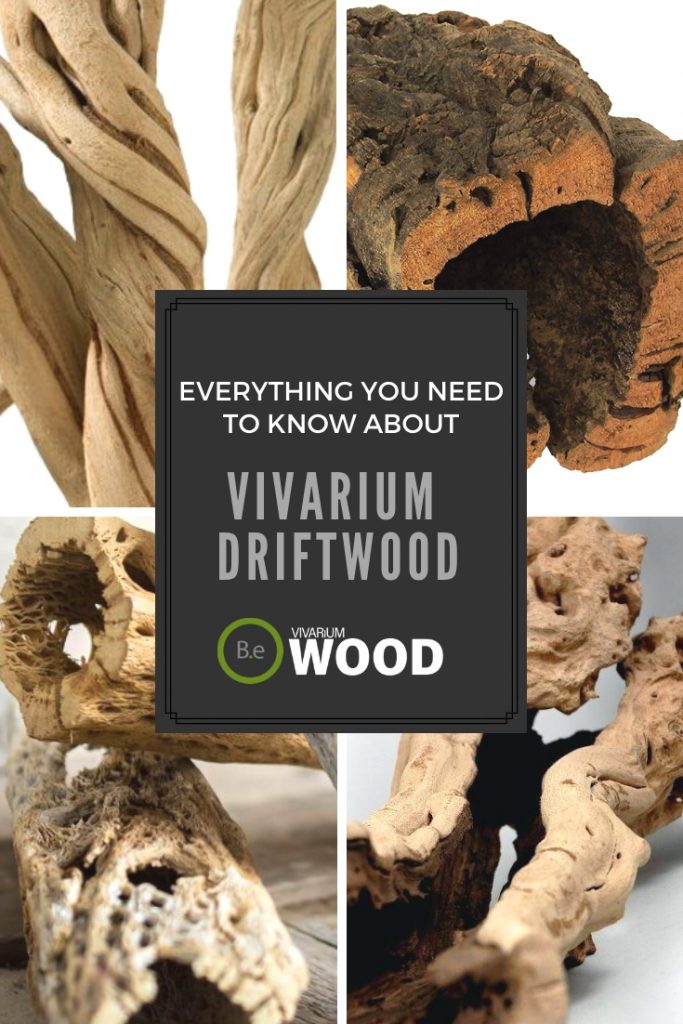

I truly hope this guide was insightful and helps make you a better hardscape designer. After digesting this work you should now be able to not only identify potentially great pieces of wood suitable for your next build… But also have a good understanding of how to manage it properly prior to putting it into place. If there are any particular types of driftwood not mentioned here that you would like for me to cover, feel free to let me know down below. Has any particular vivarium wood piqued your interest the most?
Frequently Asked Questions
You can use a variety of woods for a vivarium, such as pine, cedar, redwood, or other hardwood. You should avoid using wood products such as particle board and softwoods like spruce and fir.
- Sand the Wood: An important first step to making the wood safe for your vivarium is to sand it down until it is smooth and free of jagged edges.
- Boil the Wood: Boil the wood in water for at least 20 minutes. This will help to kill off any microbes living in the wood and make it safe for your vivarium.
- Treat the Wood: Once the wood has been boiled and sanded, use a chemical-free treatment to help preserve it. This could include alcohol-free mineral oil, a baking soda and water mixture, or plain white vinegar.
- Allow the Wood to Dry: After treating and boiling the wood, be sure to allow it to dry completely before using it in your vivarium.
- Rinse off the Wood: Once the wood is completely dry, use a hose to rinse off any debris from the treatment or boiling steps.
- Use the Wood: Once the wood is completely dry and rinsed off, you are now ready to use it in your vivarium.
Certain woods can be toxic to reptiles and should be avoided when choosing materials for their enclosures. These woods include walnut, cedar, and redwood, as they produce oils and resins which can lead to respiratory problems and skin irritation when inhaled or touched.
Reptiles are sensitive to the terpene oils found in pine. These oils are especially toxic to reptiles and can paralyze their respiratory systems if ingested, leading to death. As a result, pine wood and needles should not be used in the enclosure or area where reptiles frequent and feed.
- Purchase an appropriate sealant for the reptile enclosure.
- Clean the wood thoroughly with a mild detergent and let it dry completely.
- Apply a coat of sealant primer and let it dry for the time specified in the instructions.
- Once the sealant primer has dried, apply multiple coats of sealant and let each coat dry for the time specified in the instructions.
- Once all coats of sealant are dry, sand the surface to ensure a smooth finish.
- Apply a final coat of sealant and let it dry fully before placing any reptile furniture in the enclosure.


